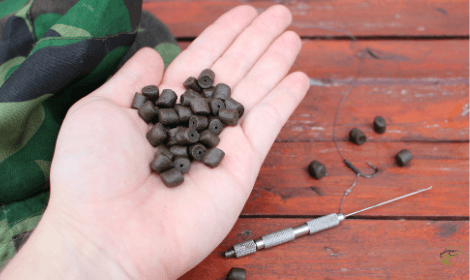
Let’s get it out there: carp fishing with pellets can be easy, it’s not difficult. I know you aren’t still convinced, and you must have questions like:
- Why choose pellet bait over other baits?
- Which pellet type to pick?
- And what happens if we do not mix micro pellet for method feeders properly?
Well, I have answers to all your questions in this article. It’s a guide where we’ll be discussing everything from pellet size and colour to texture and types. From the very definition of pellets to how you can catch carp using them.
Moreover, plenty of information on pellets and catching carp with them is available by the end of this article, so be sure to stick around. Now without further ado, let’s dive in!
What Are Pellets?
So, let’s begin with the definitions, shall we? Alright. Well, pellet is a modern food created to feed fish, made up of a mixture of vegetable proteins and binding agents (wheat) that has undergone extrusion.
More elaborately, all the raw ingredients are forced through a small tube, which creates a sausage-like mix, that is made harder by steam-cooking. Once done there, it’s cut into smaller pieces so that you can use to catch carp.
Other than vegetable matter, pellets contain fats, carbohydrates, minerals, and liquid/powdered additives. The raw ingredients of these substances include soybean cake, straw meal, and so forth..
There are so many types of pellets ranging in sizes, texture, colour, and flavour. Don’t know where to start? To make it easier for you, below are some pellet types. You can choose the one according to your preference.
Different Pellet Sizes
Pellets come in different sizes, and choosing the right one can be a bit difficult. But don’t worry, I have gathered all the sizes and their description here for you.
1mm Pellet
These tiny size pellets are best to use in winter, where you don’t want fish to gorge, as bites and feeding are scarce. This pellet size is good for catching the F1 strain of carp, and you can use it with a method feeder.
2mm Pellet
If you are using a method feeder, this Pellet is an excellent choice to feed fish in cold water. You can even scald these with boiling water to stick to your mould with the added benefits of releasing attracting quicker but be cautious! Adding too much water will not let them fall off the feeder.
4mm Pellet
If you want a pellet that catches almost all manner of species, then this is the right size to pick. You can use it as a loose feed and it’s the best size to use on a hook.
6mm Pellet
You can catch average sized carp with this pellet, but they are better for catching big fish.
8mm Pellet
The 8mm pellet is a great size for many commercial carp baggers, and you can use a hair rig or band when using it. Again, it’s best to catch bigger fish.
This list should make it easier for you to pick the right pellet size. If you still have any queries, let me know in the comments down below.
Texture
As strange as it might sound: yes, carp have a texture preference when it comes to pellets.
Experienced anglers say that a texture should mimic natural carp food such as worms. If it’s soft, then fish will take time to chew it, and meanwhile, your hook can catch hold. On the contrary, fish will swallow harder bait right away. Hence, reduce the chance of catching carp.
Isn’t it getting stranger and stranger? Well, carp even fancy colourful food too. Let’s learn a bit about different bait colours.
What Colour of Bait to Use?
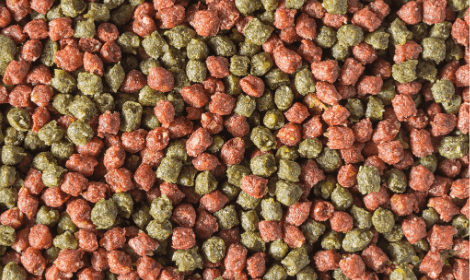
So, it turns out that some carp stick to a particular bait colour, whereas some choose their bait colour according to their surroundings.
Pellet baits are available in multiple colours that vary from dull to bright. For starters, you can choose the one that best contrasts with your surroundings or is visible in murky water.
If you ask me to choose one, I’d prefer bright fluorescent colours like pink, red, green, or yellow as they will grab carps attention. Try using yellow to resemble corn or a food colour, which mimics the food that carp eat naturally.
If you find it hard to select the correct colour, then choosing flavour can be twice as hard as picking a colour. But, I’ll break it down for you easily.
Choose the Right Flavour
The flavour is an essential tactic in carp fishing. Pellet bait comes in many varieties ranging from spicy, fishy, nutty, citrus, fruity to sweet. Moreover, these days bait companies are combining flavours such as Tutti Frutti with pineapple or plum with pineapple.
Carp’s sense of smell and taste is powerful. They can sense their meal even in murky water. Therefore, pick the flavour that matches the food taste that carp eat daily.
The local tackle shop will offer many other baits such as pop-up and boilies. So, why would you choose pellets over other baits for carp fishing?
Why Should You Use Pellets?
Now an important question: why? If you’ve read everything until now, you must have some ideas as to why you should be using pellets, but still, let’s break it down further.
Once a carp eats a pellet, it’s hard for it to stop because of the pellet’s protein content. Sometimes different recipes increase the nutritional value and voila, the carp are addicted.
Other than “addiction”, as I’ve already mentioned, pellets can be attractive because you can easily attract a carp from food appearance and taste. If you try fishing with Tutti Frutti flavour, chances are you will get an exceptional response because of its colour and flavour.
Plus, it comes in both high and low oil content you can pick according to the weather and fish type, which makes it a very personalized fishing experience, resulting in higher catches.
Another advantage is that some pellets take longer to break down, and some breakdown easily. The pellet then goes to the bottom of the lake and starts dissolving in the water. The dissolved particles then send scent to carp, which they smell, and start following them to find the bait. Whether it be a pre-baited area or your hookbait.
Hence, this helps in catching carp. But there are different varieties of pellets in the market, which works best for you will depend on the tactic you wish to perform and the venue you are fishing.
Types of Pellets
All baits are not created equally. Some types of baits are low in oil content, some take longer to breakdown, and others are great for adding to a hair rig. Let’s look at different pellet types.
Trout Pellets
Carp love these pellets as it comprises salmon fry crumb and is rich in protein and oil, therefore best to use in summer. Why in summer? Oil will disperse better in the warmer water.
Halibut Pellets
Halibut pellets are high in oil content, nutrients, and proteins. These pellets are good at creating beds of free bait and often are drilled or threaded on a hair. If you want to catch big carp, chub, and specimen bream, then you should try these.
Hemp Pellets
Only a few fresh-water fishe don’t like them but they are still excellent carp and tench attractors. These pellets break down into mush and work well in groundbait mixes and PVA bags. You can also use them as loose feed. You can use them throughout the year because of their low oil content.
Carp Pellets
If there’s a ban on trout and halibut in your area because of their high oil, you can use carp pellets. These pellets contain vegetable proteins, low oil and breakdown easily. Carp pellets are best used as loose feed and not as a hookbait.
Corn Steep Liquor Pellets
CSL pellet breakdown rapidly in water and forms a fine bed of attractive particles. You can also use these as loose feeds and in method mixes or PVA bags. Many species, particularly barbel and carp, love them.
Soft Pellets
These pellets contain moisture and are small that makes them ideal for carp and silverfish. These are soft and available in sizes ranging from 1mm to 4mm. You can use them directly on the hook or hair rig them.
Micro Pellets and Hook Bait Pellets
So, what’s the difference with micro and hook bait pellets? Let’s figure this out as well.
Micro Pellets
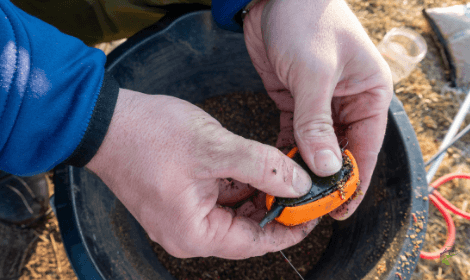
Micro pellets are suitable for smallmouth fish, such as carp pellets ranging from 1mm to 4mm. These are low in oil, and you can use them as loose feed. Using a method feeder with micro pellets is the most productive fishing method.
This method will increase your chances of catching carps. Go for micro pellets when choosing pellets to mould around your feeder method.
READ: How to prepare micro pellet mixes for your feeder method?
Preparing Micro Pellets
The first thing you need is a large box with a small hole in its lid. Half fill the box with correct pellets and cover them with lake water up to around 10mm. Then tightly cover them with a lid for 2 minutes. Hold the box upside down and shake all the excess water out of the lid in small holes. Shake until the water stops coming. This method will take around 15-20 minutes to prepare.
Spod Mix
Spod mix can also use pellets or some of the combination of baits below;
- Sweet corn
- Tiger nut
- Tuna
- Ground bait
- Pellet
Besides water, micro pellets can be used as a binding agent to hold everything together.
Hookbait Pellets
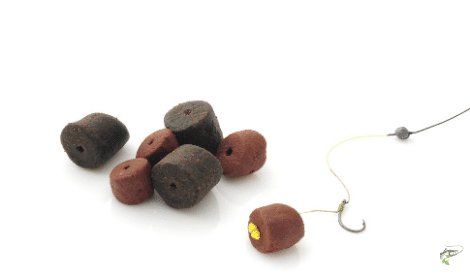
You can use normal pellets as loose feed or hook bait pellets ranging from 6mm to 20mm when fishing for large-sized fish. It’s hard to get a hook through these pellets as they are hard. However, you can get around this by using various methods:
Banded Pellets
Use a rubber bait band around a hook bait next, push the hook under the rubber band and go away. Another method is to drill your Pellet, but this takes extra time and effort.
Drilled Pellets
Another great way to present a pellet hookbait is to put it on a hair rig. For this method, you need a baiting needle and some hair stops. Pre-tied hair rigs will also work just fine for this. These pellets will be pre-drilled so you can easy put the pellet onto your rig.
Expander Pellets
These pellets remain in shape for a long time and are ideal for directly adding to hook bait. You can add these hard pellets to water to soften and create a spongy texture. Expander pellets are floating pellets, but after soaking, they sink because of hook weight. You can pump expander pellets and use them as feed.
Now we’ll see why mixing micro pellets is essential.
Mixing Micro Pellets
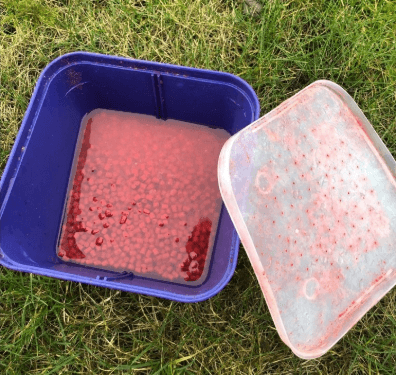
Mixing micro pellets properly in the method feeder is very important: Because the mixture should not be mushy otherwise, it will stick to the feeder, and it’s become hard for carp to feed on it. Similarly, the Pellet should not be too dry, or it will collapse during the cast or before the feeder sinks to the bottom.
Always test your micro pellet mixes after mixing to make sure they are ready to use.
Micro Pellets Testing
Pick a ball of mixed micro pellets and mould it around your feeder. Next, drop it at a point where you can watch what happens. If the pellets breakdown quickly just the moment after they hit the water, this means it’s too dry. Soaking your pellets in a little more water will solve the problem.
But if you find out that the Pellet does not break even a few minutes after hitting the water, then it’s too wet. Adding a bit of ground bait can help to dry out the mix. Ideal pellet mix sticks to the feeder and starts to break after a few minutes of resting at the bottom of the water.
Choosing the suitable method and preparing it correctly is very important. Once you get this right, you are ready to catch your fish.
Give Pellets A Go!
By now, you already know everything about carp fishing using pellets. Next time when you go fishing, try using pellets to see if it works for you or not.
If you’re still unsure, I’d say that it’s a protein-packed feed that carps love to feed on and has bright fluorescent colours, which is good for grabbing carp’s attention. Besides colours, pellets have a wide range of varieties you can pick that suits your target and venue.

